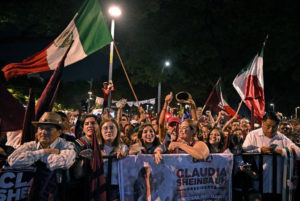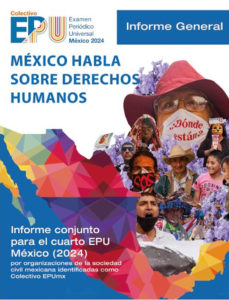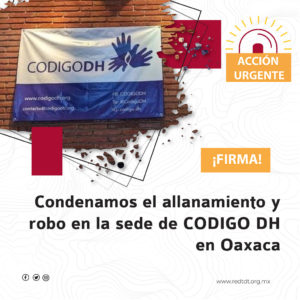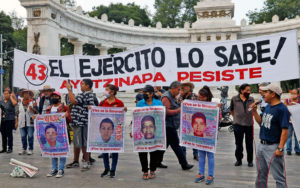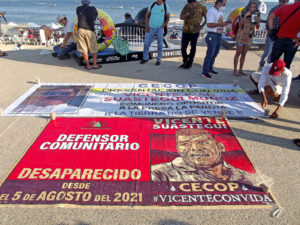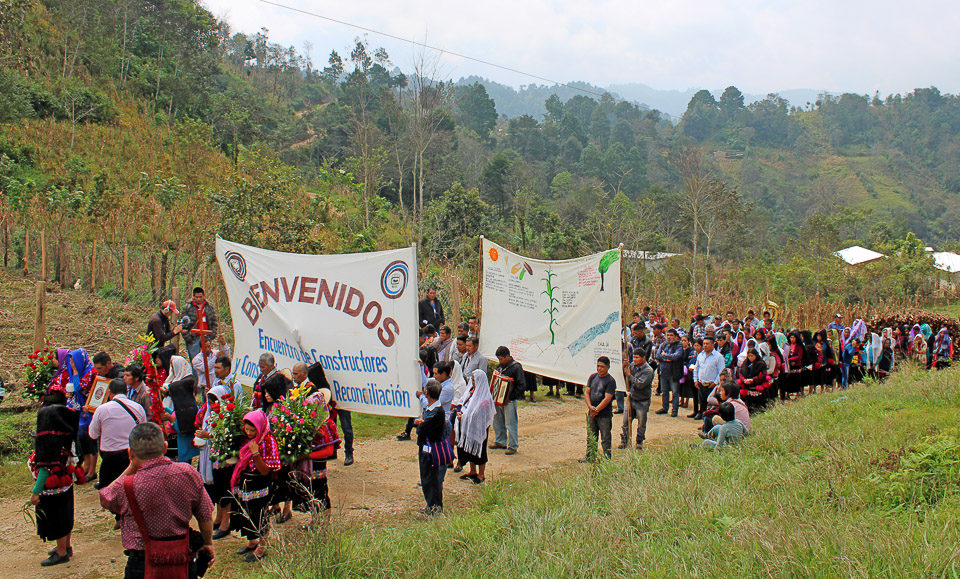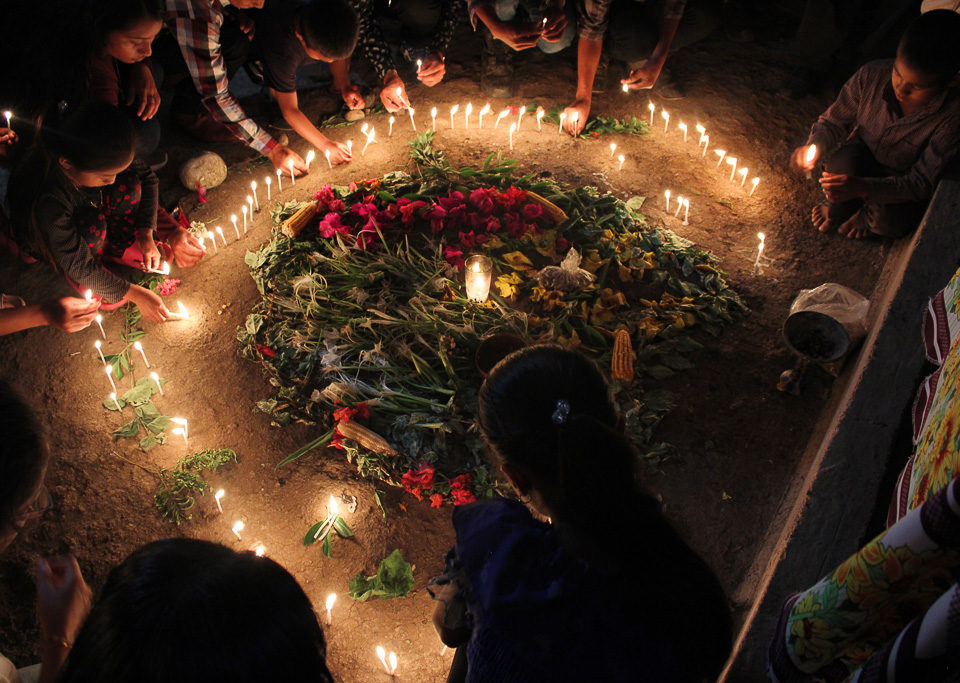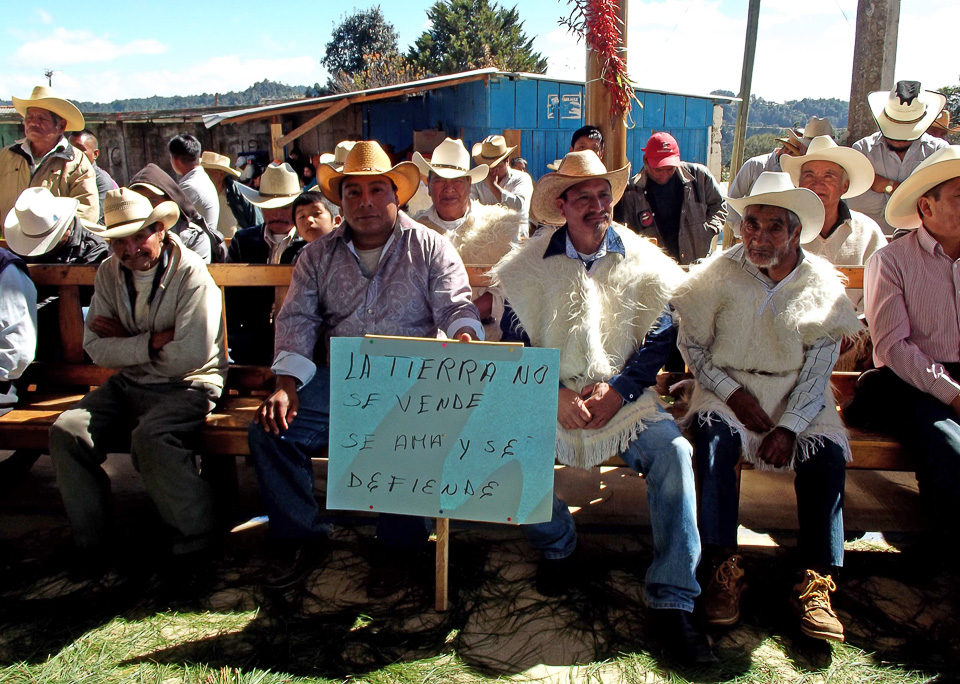
SIPAZ Activities (Mid-February to mid-May 2024)
30/06/2024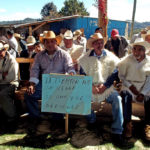
FOCUS: Southeast Mexico, an X-ray of Dispossession
18/09/2024
O n June 2nd, Claudia Sheinbaum was elected Mexico’s first female president, gaining a 30-point lead over candidate Xochitl Galvez (PRI, PAN, and PRD, historic parties in Mexico).
Sheinbaum’s party, the National Regeneration Movement (MORENA), together with its allies, won a majority in both chambers of the Congress of the Union. This will allow her to carry out the constitutional reforms of the so-called “Plan C,” bequeathed by President Andres Manuel Lopez Obrador (AMLO), in addition to consolidating the flagship megaprojects of the current administration. With an electoral roll of 98.3 million people, Sheinbaum obtained 35,923,984 votes, a significant increase compared to the 30.1 million votes that AMLO obtained in 2018. MORENA also won in Mexico City and retained power in five of the nine governorships that were at stake.
These overwhelming results cannot hide the fact that the campaigns were characterized by a high level of political-electoral violence in much of the country. The international organization ACLED (Armed Conflict Location and Event Data) recorded 540 incidents of violence against political players between September 2023 and June 2024. These data, contrary to what the federal government claims, show that this electoral process has been the most violent in history. Of the 330 violent incidents recorded during the campaign, 216 affected candidates, supporters or their relatives, and at least 95 resulted in one or more deaths. Most of the violent attacks, more than 80% of the cases, occurred at the local level. “Although competition between organized crime groups drives much of the political violence, at least 30% of incidents involve rioting and property destruction, suggesting that local power struggles and community claims of irregularities during the process, or rejection of the results, can also trigger violence against political figures,” ACLED added.
Judicial Reform: Improvement or Risk of Greater Political Control and Impunity?
In June, a series of forums were held to debate the Reform to the Judiciary proposed by AMLO. This proposal recommends reducing the number of ministers in the Supreme Court of Justice of the Nation (SCJN) from 11 to nine. The mandate of the ministers would be for 12 years, three less than in the current formula. The two chambers into which the Court is currently divided would be eliminated, leaving its operation only in plenary sessions, which would be public. In terms of salaries, it is established that the remunerations of the ministers and judges may not exceed what the President of the Republic receives. In addition, the mechanism for electing the representatives of the Judiciary would be modified, they would be elected by the citizens every three years, after being proposed in equal parts by the Presidency of the Republic, the Congress of the Union and the Judiciary itself.
Civil organizations argue that the proposal omits fundamental aspects, such as the need to reform the prosecutors’ offices, given that the main problem of impunity in Mexico is related to public ministries. They also highlight the importance of putting more emphasis on local judicial powers, redesigning the structure of the police forces in charge of investigating crimes, improving the technical capabilities and independence of the forensic services, and increasing the resources and staff of the public defenders’ offices. “Electing judges, magistrates and ministers by popular vote will not contribute to addressing any of these needs, but it will, unfortunately, generate new and worrying problems,” said the PRODH Center.
Margaret Satterthwait, Special Rapporteur for the United Nations on the Independence of Judges and Lawyers, expressed her concern about the initiative, especially with regard to the election by popular vote and the reduction of salaries of judicial personnel. “I am particularly concerned about the context in which these reform proposals are being carried out, given the alleged intimidation of judges and reports of interference in judicial independence by the executive and legislative branches,” she said.
Meanwhile, the Mexican peso depreciated following MORENA’s announcement to implement President Lopez Obrador’s reforms in July and August. Investors fear the government will approve “radical changes” to the Constitution, which could be seen as a dismantling of democratic checks and balances.
Numerous Pending Human Rights Issues for President-elect
In May, the National Network All Rights for All (Red TDT) presented a report on the human rights situation in Mexico during this government. Regarding human rights defenders, 92 cases of extrajudicial executions were documented, which represents a 50% decrease compared to the previous administration, but it remains “a tactic used to inhibit and dismantle the social struggle and the defense” of fundamental guarantees. Most of the victims were defenders of land and territory, the environment, and the self-determination of indigenous peoples; these cases were mainly recorded in Oaxaca and Chiapas. The report also highlighted that, according to the data collected, 44 journalists have been killed during the current administration, compared to 47 during the previous administration. In addition, cases of limitation of the right to freedom of expression and protest have been documented. Also, “smear campaigns have continued, which have been denounced by various organizations,” including the President of the Republic.
In July, the organization Article 19 presented the report “Pending Rights,” which details the violations of freedom of expression during the Lopez Obrador administration. There were 3,408 attacks against the press, 561 of them in 2023, which represents one attack every 14 hours. In addition, 46 journalists were murdered, and the State remains the main aggressor, responsible for 45.75% of the total. The report highlights that “During the six-year term of office, 179 attacks were recorded in the ‘morning press conferences’ and identified that municipal and state authorities from 20 entities of the Republic repeated the same stigmatizing speech 62 times.” It also points out the concentration of spending on official advertising, with ten media outlets accumulating 47.08% of the resources during the six-year term. Despite claims that there was no longer any spying, the report claims that the administration continued to acquire surveillance equipment.
Another worrying aspect on the human rights agenda is militarization. In June, Claudia Sheinbaum announced that she will support the reform proposed by AMLO that involves the definitive integration of the National Guard into the National Defense Secretariat (SEDENA). She indicated that her security policy will be based on addressing the causes, having a more effective National Guard, improving intelligence and investigation, and ensuring coordination between institutions. However, civil organizations have expressed their concern, pointing out that “the participation of the military in areas of civilian life could undermine the security of the population and increase human rights violations, in addition to putting at risk the principle of separation of powers and judicial independence.”
In July, within the framework of the Universal Periodic Review (UPR), a mechanism of the UN Human Rights Council, the Mexican State received 318 recommendations related to human rights. The government rejected 14 of them on the issues of militarization, excessive use of force, espionage, unofficial pretrial detention, forced displacement and detention of migrants. Civil, national and international organizations regretted “the State’s position in rejecting so many recommendations for the first time, which contrasts with the messages of commitment to respect for human rights.” They called on the next administration to take all the recommendations “as a guide for the adoption of concrete government policies and actions with a rights perspective.”
The Role of the United States in Security and Human Rights Issues in Mexico
In June, US President Joe Biden announced a new executive order that will limit asylum applications at the border with Mexico. This measure will allow rapid deportations if a specific number of arrests of people who crossed the border irregularly is exceeded, unless they prove that they are being persecuted or are at risk of torture if they are expelled. AMLO considered that these new measures respond to the presidential elections in November, when migration is a priority issue for the American electorate. He stated that “they are applying a policy that does not correspond to the new reality” and they use “the immigration issue for electoral political purposes, legislators take advantage and sometimes even money, by maintaining positions that, instead of helping to solve problems, complicate them.” By August, the United States had deported more than 92,000 people to more than 130 countries.
More than 20,000 weapons enter Mexico illegally every year, according to the U.S. Bureau of Alcohol, Tobacco, Firearms and Explosives (ATF), as reported by the Stop US Arms to Mexico project, an initiative of Global Exchange in July. However, only a small portion of illegally trafficked weapons are recovered. The report states that “The river of gun iron that transits from the United States to Mexico, empowering organized crime and accelerating forced migration, originates in hundreds of manufacturers and passes through thousands of local armories in the United States.” In reaction to the flow of illicit weapons, “an arms race has emerged, with arms companies exporting more and more weapons, and more militarized weapons, to police and military forces in Mexico.” In 2023, the United States “exported 12,515 military rifles to Mexico – more than to Ukraine, and second only to Israel,” it stated.
In July, U.S. authorities arrested Ismael “El Mayo” Zambada, one of the historic leaders of the Sinaloa Cartel, in El Paso, Texas. Strikingly, the Mexican Attorney General’s Office announced that it will investigate the arrest as a case of “treason,” since Zambada appears to have been handed over to the U.S. by Joaquin Guzman Lopez, son of Joaquin “el Chapo” Guzman, who was also a leader of the Sinaloa Cartel and is currently in custody. The Attorney General’s Office argued that “anyone who illegally deprives a person of their freedom in the national territory to hand them over to the authorities of another country is responsible for this crime.” Zambada’s statements have already begun to implicate several politicians linked to MORENA.
CHIAPAS: Caught Between Political-electoral and Criminal Violence
On June 2nd, in addition to federal posts, the new governor, 40 deputies, 123 municipal presidents, 875 councilors and 123 mayors were elected in Chiapas. The high levels of political-electoral violence during the campaigns placed Chiapas among the most affected states, with at least 15 murders of politicians, five of them candidates. In addition, 515 candidates for various elected posts, belonging to 11 parties and two coalitions, resigned. Likewise, 108 of the 6,977 polling stations planned could not be set up due to this same situation. Nevertheless, the election day took place with relative calm. Unsurprisingly, Eduardo Ramirez Aguilar (ERA), candidate of the coalition Let’s Keep Making History, won the race for governor with nearly 80% of the votes cast.
The violence resulting from the dispute between groups linked to organized crime remains predominant in much of the state, especially in the Border and Sierra areas. In July, the Southern Border Monitoring Collective urged the federal government to offer a comprehensive response to the situation of thousands of displaced families (some in Guatemala after crossing the border) or at risk of forced recruitment in municipalities cut off from communication by roadblocks set up by criminal groups. “The population of these municipalities is totally unprotected and abandoned by state and federal authorities, and is also being forced by criminal groups to participate in the blockades, using them as human barricades in case the rival group comes or to prevent the passage of federal forces. Given this situation, the statements of the federal authorities, headed by the President of the Republic, who minimize the humanitarian situation and place the responsibility for the events on the population accused of being the social base of the criminal groups, are of great concern,” they denounced. The Diocese of Tapachula said that the current situation in the Sierra and Border “is desperate because of the permanent presence of drug cartels fighting over territory, coming and going in the face of the indifference and apparent complicity of the National Guard and the Mexican Army.” It declared that “it is very difficult to live like this; on the one hand, kidnapped in their own homes, forced to do what they should not, with a deep sense of helplessness in the face of the incomprehensible situation they live in; the people of the cartels who dispose of the population at will, and on the other, the presence of detachments of the National Guard and the Mexican Army who do nothing for the population they see.”
Another red flag appeared in the Northern Zone. In June, a police-military operation was implemented with more than 500 elements in the town of Tila. More than four thousand people, who had taken refuge in their homes due to the violence caused by groups of armed civilians, abandoned the town. These groups left at least two dead, 17 buildings burned, businesses looted and 21 vehicles destroyed. The displaced were taken to various shelters in the state or sought refuge in the homes of relatives in other municipalities. According to testimonies, the clashes arose from the conflict between the “Autonomous” group and the group called “Karma” for control of the ejido. The TDT Network pointed out that “this scenario of violence has antecedents, which were publicly denounced, without the authorities of the three levels of government having taken the necessary measures to avoid its escalation. Throughout the last few years, several antagonistic armed groups have emerged, causing murders, threats, extortion, and various forms of violence, terrorizing the population in general.” It also recalled that “there is a dispute between organized crime groups with the participation of local armed organizations. Different indicators show that this situation could be framed in this context, where legal and illegal economies are disputed, as well as population control of the territory and communication routes.”
At the end of July in the Highlands, around 800 people from the community of La Esperanza, in Chenalho, were forced to abandon their homes due to an armed attack by the group known as “Los Herrera”. La Esperanza, located on the border between Chenalho and Pantelho, has been the scene of clashes since July 2021 between “Los Herrera” and the “El Machete” self-defense forces of Pantelho. Other communities have also been affected. Parishes in the area have denounced the increase in violence: blockades, continuous shootings and clashes have led to the forced displacement of entire communities and the death of innocent people. They asked: “given the pain of the suffering people and the indignation at the lack of governance we are experiencing in the state, the minimization that President Andres Manuel Lopez Obrador has made of the violence that has gone viral in these municipalities, we do not understand in whose hands the fight against organized crime is, since we see that criminals are becoming stronger every day in the presence of the military and the National Guard.”
OAXACA: Vulnerability of Human Rights Defenders and Journalists
In May, the Gobixha Comittee for the Comprehensive Defense of Human Rights C.A. (CODIGODH) denounced a raid on its offices in Oaxaca City, where laptops, cameras, video cameras, cash, and other goods were stolen. The organization warned that this act “constitutes a serious violation of our work defending human rights in a context of insecurity and violence.” After a second raid in the same month, CODIGODH decided to temporarily close its offices.
In July, Lorenzo Santos Torres, a community defender from Santiago Amoltepec, along with his wife and daughter, were ambushed, executed, and burned to death on a road between San Martin Lachila and San Andres Zabache, in Ejutla de Crespo. Santos Torres had survived an attack in 2013, for which the Inter-American Commission on Human Rights (IACHR) had granted him precautionary measures. With this murder, the number of defenders killed in Oaxaca during the six-year term of President Lopez Obrador has risen to 42, of which four occurred during the current government of Salomon Jara Cruz, according to Services for an Alternative Education (EDUCA).
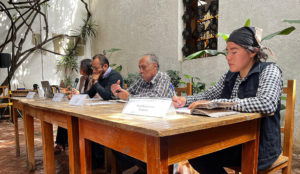
Press conference after the Civilian Observation Mission in the Isthmus of Tehuantepec © Educa Oaxaca
During the Jara Cruz administration, the Ombudsman for Human Rights of the People of Oaxaca (DDHPO) also reported 17 attacks against journalists. In July, during the Guelaguetza Oaxaqueña, photo-journalist Edwin Hernandez of El Universal was attacked while filmmaker Angeles Cruz was protesting against violence in her community, San Miguel El Grande. Consorcio Oaxaca reported that Hernandez suffered “intimidation and pushing by the Governor’s “bodyguards” in order to prevent him from documenting the filmmaker’s protest. He finally left and on the way out they pulled him and tore up his accreditation.”
One of the areas with the most attacks against defenders is the Tehuantepec Isthmus. In June, a Civil Observation Mission (COM), made up of 22 Mexican and international civil organizations, documented that, from May 2021 to May 2024, 72 attacks were recorded, with at least 226 attacks against defenders. The most recurrent attacks were intimidation (30%), harassment (28%), threats (10%) and physical attacks (7%). In addition, three homicides of defenders were documented: Jesus Manuel Martinez (2022), Felix Vicente Cruz (2023) and Noel Lopez Gallegos (2023). The COM indicated that the presence of the Army, Navy and National Guard “fosters a hostile and intimidating climate, which has generated a systematic violation of fundamental rights against communities and peoples (…) in the Tehuantepec Isthmus.” The Commission recommended that the authorities “urgently and effectively halt the militarization process in order to guarantee effective protection of the rights to self-determination, territory and consultation,” as well as investigate and punish the crimes and human rights violations committed.
GUERRERO: Violence and Impunity
In May, La Montaña Tlachinollan Human Rights Center noted that “the political-electoral scenario is devastating in Guerrero.” “The party leaders do not care about the violence that every day brings mourning to homes and threatens the population that fights for its survival. The destructive power of criminal groups has placed itself above the authorities.” Guerrero was one of the states with the highest number of victims of political violence, registering at least 80 cases. Despite this, the election took place with relative calm. Guerrero was one of the four states in the country that contributed the most votes to the president-elect Claudia Sheinbaum. MORENA and its allies also won the elections in most of the municipalities of Guerrero and the majority of the deputies.
Violence and impunity continued to mark the situation. In June, the mayor of the indigenous municipality of Malinaltepec was murdered, having been detained by an armed group. Also, the adviser of the Regional Coordinator of Community Authorities (CRAC-PC) and former commissioner of Cuanacaxtitlan, Leonel Felix Flores, was deprived of liberty and murdered in the municipality of San Luis Acatlan, on the Costa Chica of Guerrero. “It is clear that the armed groups that swarm in the region and in the state enjoy total impunity,” Tlachinollan denounced. In July, the Emiliano Zapata Indigenous and Popular Council of Guerrero (CIPOG-EZ) denounced that two of its members were murdered in the municipality of Chilapa. It declared that in six years 56 of its militants have been murdered and 23 are missing. “We want to make it clear that we are alone, that the STATE has abandoned us to our fate, that it leaves us in the hands of crime, as occurs (…) in practically the entire country,” it stated.
Following the release of a report on the Ayotzinapa case presented in July, AMLO denied the involvement of the army in the disappearance of the 43 students in Iguala in 2014. However, the students’ families stated that the participation of the army “is an irrefutable truth,” backed by “numerous testimonies and ministerial statements that confirm that the army was in the streets that day and shamefully participated in the disappearance of our children.” “From his presidential seat, without any real basis, he tries to give us a summary of speculations and conjectures in justification of a campaign promise that he did not fulfill at the end of his term.” They assured that they will continue to demand the appearance of their children and of the hundreds of thousands of missing people in the country. AMLO, for his part, has maintained that the accusations “without proof” against the army could be the result of “a desire for revenge” against the institution, “as they wanted to do in the case of General Salvador Cienfuegos or as they are doing now against me with a smear campaign, without proof.”
In August, three years after the disappearance of the defender Vicente Suastegui Muñoz, the relatives of the member of the Council of Ejidos and Communities opposed to the La Parota hydroelectric project (CECOP) again demanded that he be presented alive. They criticized a judge’s decision to revoke the sentence against two alleged perpetrators of the disappearance for alleged violations of due process. Tlachinollan denounced that “it is incredible that in Acapulco, where all the State security forces are located and where they have meetings every morning to analyze the situation of violence that occurs in the port, they are incapable of identifying the modus operandi of the perpetrators and of not locating the places where they equip themselves and commit their misdeeds. (…) A larger budget is allocated to build National Guard barracks to guarantee security in the port, however, people do not see tangible results with the arrival of more elements of the National Guard.”

